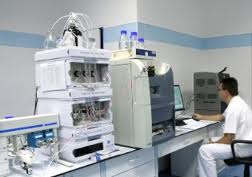 In 1972, Carpino introduced the 9-fluorenylmethoxycarbonyl (Fmoc) group for Nalpha protection for Fmoc peptide synthesis. The Fmoc group requires moderate base for removal, and thus offered a chemically mild alternative peptide synthesis to the acid-labile Boc group.
In 1972, Carpino introduced the 9-fluorenylmethoxycarbonyl (Fmoc) group for Nalpha protection for Fmoc peptide synthesis. The Fmoc group requires moderate base for removal, and thus offered a chemically mild alternative peptide synthesis to the acid-labile Boc group.
In the late 1970s, the Fmoc peptide synthesis was adopted for solid-phase applications. Fmoc-based peptide synthesis strategies utilized t-butyl (tBu)–based side-chain protection and hydroxymethylphenoxy-based linkers for peptide attachment to the resin. This was thus an “orthogonal” scheme requiring base for removal of the Nalpha-protecting group and acid for removal of the side-chain protecting groups and liberation of the peptide from the resin. The milder conditions of Fmoc peptide synthesis chemistry as compared to Boc chemistry—which include elimination of repetitive moderate acidolysis steps and the final strong acidolysis step—were envisioned as being more compatible with the synthesis of peptides that are susceptible to acid-catalyzed side reactions. In particular, the modification of the indole ring of Trp was viewed as a particular problem during Boc-based peptide synthesis (Barany and Merrifield, 1979), which could be alleviated using Fmoc chemistry. One example of the potential advantage of Fmoc chemistry for the synthesis of multiple-Trp-containing peptides was in the synthesis of gramicidin A. Gramicidin A, a pentadecapeptide containing four Trp residues, had been synthesized previously in low yields (5% to 24%) using Boc chemistry. The mild conditions of Fmoc chemistry dramatically improved the yields of gramicidin A, in some cases up to 87% (Fields et al., 1989, 1990). A second multiple-Trp-containing peptide, indolicidin, was successfully assembled in high yield by Fmoc chemistry (King et al., 1990). Thus, the mild conditions of Fmoc chemistry appeared to be advantageous for certain peptides, as compared with Boc chemistry.
One of the subsequent challenges for practitioners of Fmoc peptide synthesis chemistry was to refine the technique to allow for construction of proteins, in similar fashion to that which had been achieved with Boc chemistry. Fmoc chemistry had its own set of unique problems, including suboptimum solvation of the peptide/resin, slow coupling kinetics, and base-catalyzed side reactions. Improvements in these areas of Fmoc chemistry (Atherton and Sheppard, 1987; Fields and Noble, 1990; Fields et al., 2001) allowed for the synthesis of proteins such as bovine pancreatic trypsin inhibitor analogs, ubiquitin, yeast actin-binding protein 539-588, human beta-chorionic gonadotropin 1-74, mini-collagens, HIV-1 Tat protein, HIV-1 nucleocapsid protein Ncp7, and active HIV-1 protease.
The milder conditions of Fmoc peptide chemistry, along with improvements in the basic chemistry, have led to a shift in the chemistry employed by peptide laboratories. This trend is best exemplified by a series of studies (Angeletti et al., 1997) carried out by the Peptide Synthesis Research Committee (PSRC) of the Association of Biomolecular Resource Facilities (ABRF). The PSRC was formed to evaluate the quality of the synthetic methods utilized in its member laboratories for peptide synthesis. The PSRC designed a series of studies from 1991 to 1996 to examine synthetic methods and analytical techniques. A strong shift in the chemistry utilized in core facilities was observed during this time period—i.e., the more senior Boc methodology was replaced by Fmoc chemistry. For example, in 1991 50% of the participating laboratories used Fmoc chemistry, while 50% used Boc-based methods. By 1994, 98% of participating laboratories were using Fmoc chemistry. This percentage remained constant in 1995 and 1996. In addition, the overall quality of the peptides synthesized improved greatly from 1991 to 1994. Possible reasons for the improved results were any combination of the following (Angeletti et al., 1997):
1. The greater percentage of peptides synthesized by Fmoc chemistry, where cleavage conditions are less harsh.
2. The use of different side-chain protecting group strategies that help reduce side reactions during cleavage.
3. The use of cleavage protocols designed to minimize side reactions.
4. More rigor and care in laboratory techniques.
The next step in the development of solid-phase Fmoc peptide synthesis techniques includes applications for peptides containing non-native amino acids, post-translationally modified amino acids, and pseudoamino acids, as well as for organic molecules in general. Several areas of solid-phase synthesis need to be refined to allow for the successful construction of this next generation of biomolecules. The solid support must be versatile so that a great variety of solvents can be used, particularly for organic-molecule applications. Coupling reagents must be sufficiently rapid so that sterically hindered amino acids can be incorporated. Construction of Fmoc peptides that contain amino acids bearing post-translational modifications should take advantage of the solid-phase approach. Finally, appropriate analytical techniques are needed to assure the proper composition of products.
For more information on Custom Peptide Synthesis, Synthetic Peptide, Peptide Synthesis , Please visit: Custom Peptide


